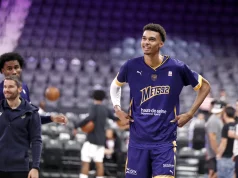The San Antonio Spurs have been one of the hottest teams in the league over the last 10 games, going 8-2 and currently holding a league-best 8-game winning streak. Since their loss to the New York Knicks on February 24, the Spurs have turned their biggest flaw, their defense, into their strength over the last nine games.
During their 8-game win streak, the Spurs are playing the best defense in the league. Now that game 70 has been completed, let’s review how the Spurs have performed lately on both ends of the floor, and what has made their defense make the turnaround.
If you’re new to the 10-game evaluation series, here are Volume’s 1-6. Most of the stats used in this evaluation are from CleaningTheGlass.com and on CTG, a ranking is provided for the stats. I created the following rating system based on the rankings:
Elite – Rank near Top 5
Good – Rank near Top 10
Average – Rank near 15th
Improvement – Rank near 20th
Ugh – Rank near 25th
Ouch – Rank near 30th
Section I. Scoring
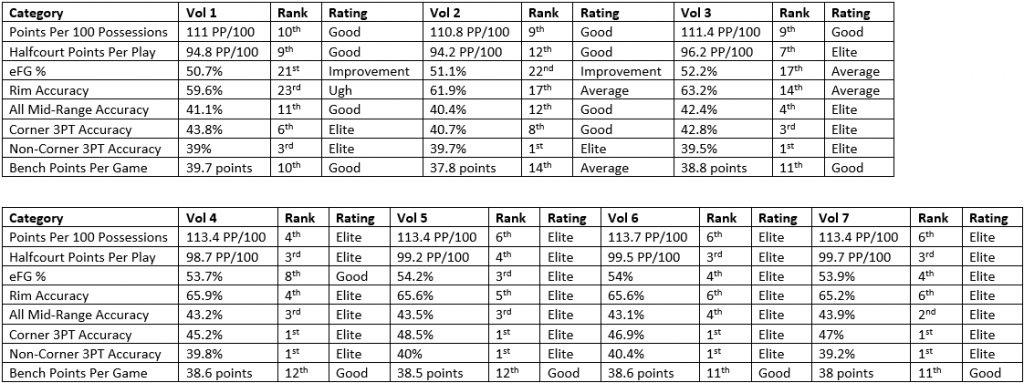
Where do the Spurs frequently take shots from?

Section II. Ball Movement

Now through 70 games of the season, the Spurs’ offensive system is continuing to work. Take care of the ball, find the best shots that fit the strengths of their high-usage scorers, and surround their mid-range shooters with very accurate 3-point shooters. This style of offense that doesn’t fit the modern NBA with less shots from three, the paint, and free throw line, is still working for the Spurs, as they continue to rank 6th in scoring 113.4 points per 100 possessions.
One statistic that is still taking some getting used to seeing is the Spurs’ decrease in ranking from the ‘Passes Per Game.’ After being the team known for their beautiful ball movement during their 2014 NBA Championship run, the Spurs have fallen all the way down to 27th in passes per game, as their possessions see less ball movement in the hands of their Go-To Four of DeMar DeRozan, LaMarcus Aldridge, Derrick White, and Rudy Gay.
Although the overall ball movement may not be there anymore, you can still see the Spurs emphasizing the good-to-great shot as their secondary assists per game numbers are still near the top-10 level. Now that the Spurs have four go-to scorers who can each create on their own, the team will see in the next few weeks how well this style of offense will work in the playoffs (should the Spurs qualify).
Section III. Defense


Where do opponents shoot from and how accurate are they against the Spurs’ defense?
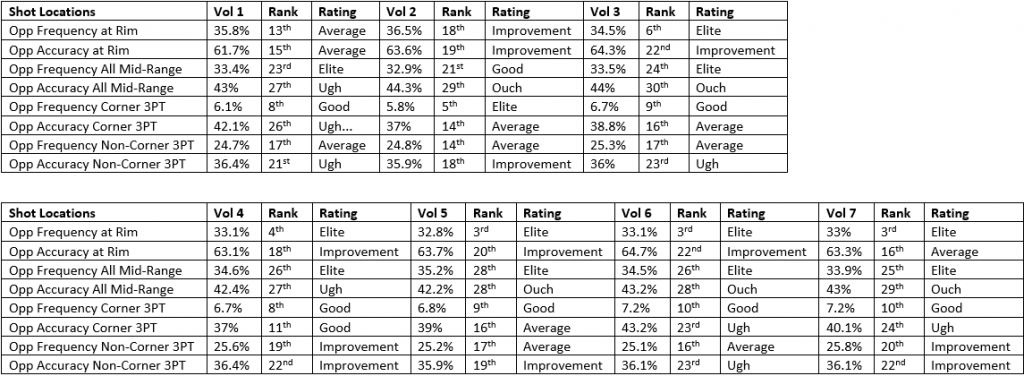
While playing better defense over the last nine games has made the overall numbers look slightly better, most of those overall rankings still aren’t at an elite level. To really see how well the Spurs are playing on defense, check out their overall numbers compared to the defensive numbers over the last 9 games.
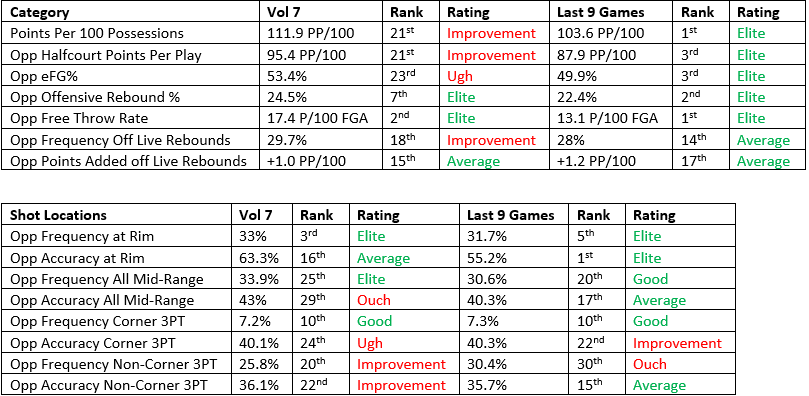
As you can see from the numbers above, the Spurs are playing elite level defense over the last nine games. Here are a few reasons why the Spurs have been so successful lately on defense:
Poeltl starting – Spurs Head Coach Gregg Popovich has been using a traditional starting lineup in the frontcourt by having LaMarcus Aldridge and Jakob Poeltl start together at the 4-5. By having two traditional, drop-back bigs, there’s some give and take that’s working for the Spurs defensively. The Spurs are giving (or sacrificing) more above the break threes to the opponent, and in return, taking away more accurate shots at the rim and mid-range, as well as the free throw line. This method defensively is like the Milwaukee Bucks’ methods of closing off the rim and free throw line, but allowing the least accurate three – the above the break three. While this method has been working, it frequently allows the opponent to stay in games because all they have to do is get hot for a few possessions from distance to either shrink a Spurs double digit lead, or retake the lead entirely. For now, this approach for the Spurs has been working.
Something Popovich has also mentioned is Derrick White being the first line of defense out on the perimeter. His ability to limit dribble penetration from creative guards and wings is another key factor for the Spurs’ improvement defensively.
Schedule, team health, and continuity – Some other factors for the Spurs’ turnaround defensively are the schedule, health of the team, and continuity. The Spurs reached a point of the schedule when they faced some opponents with injury and schedule issues, like Paul George being out for the Thunder and playing the Bucks on the second night of a back-to-back. The Spurs have also played most of these games at home in the AT&T Center. The Spurs have been able to stay relatively healthy over the last 10 games too, as only Rudy Gay missed consecutive games by catching the flu. With more games together, the Spurs’ nine-man rotation only gets better. Since January 1, when their core nine play in the same game, the Spurs are 10-3. This is the nine-man rotation they’re hoping is healthy and ready for the playoffs.
Now, to provide a visual glimpse of which specific Spurs players are excelling or not playing well on each end of the floor, you can study the two charts below. Each chart shows the 1st, 15th, and 30th ranked offenses and defenses, where the Spurs are ranked, and where each specific player would rank.
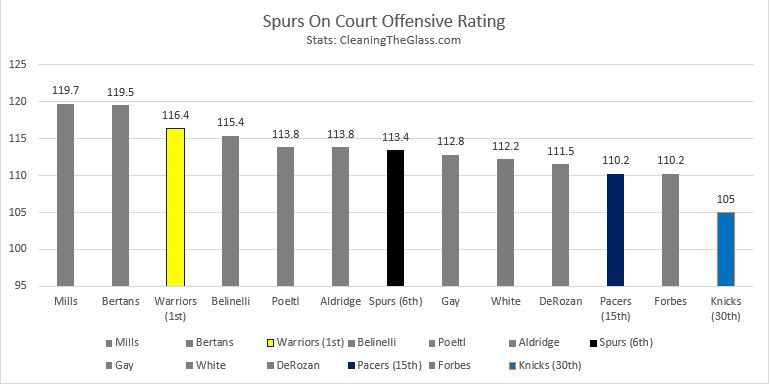
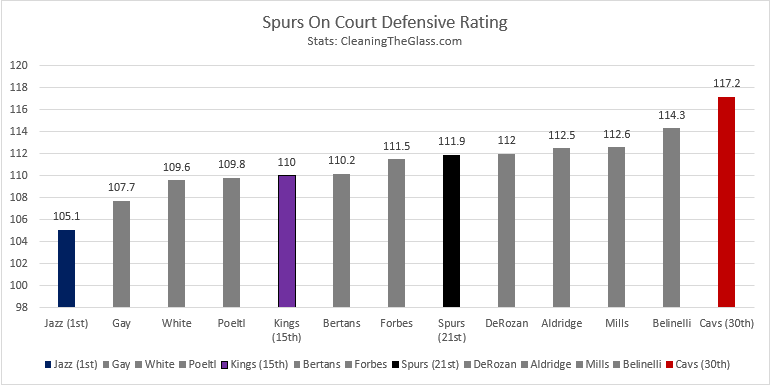
Section IV. The Competition
| Opponent is… | Spurs Record |
| .500 and Above | 19-16 |
| Below .500 | 22-13 |
At 19-16 against teams that are .500 and above, the Spurs are tied with the Blazers for 3rd in the Western Conference when looking at the that record type. The Spurs have also recorded at least one win against all the other seven Western Conference playoff teams that are expected to make the playoffs.
Section V. The Next 12
In their final 12 games of the season, the Spurs will face the Warriors, Heat, Rockets, Celtics, Hornets, Cavaliers (twice), Kings, Hawks, Nuggets, Wizards, and Mavericks.
Data gathered from CleaningTheGlass.com, NBA.com/stats, and HoopsStats.com as of 03/17/2019 at 5:30 PM CST.



